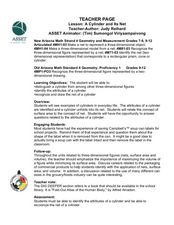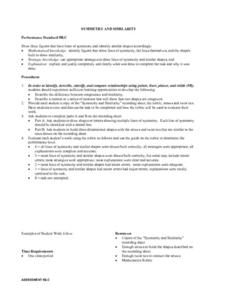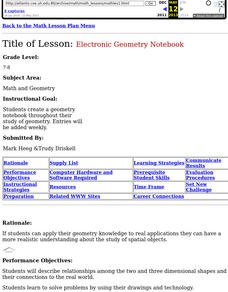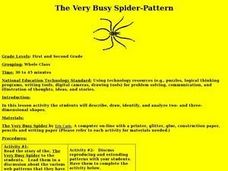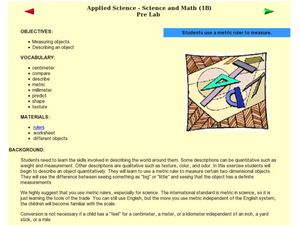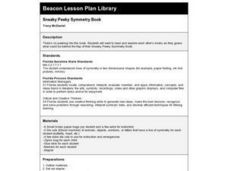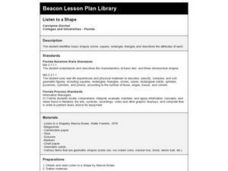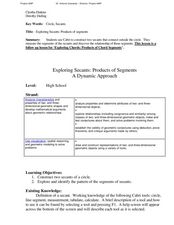University of Colorado
Patterns and Fingerprints
Human fingerprint patterns are the result of layers of skin growing at different paces, thus causing the layers to pull on each other forming ridges. Here, groups of learners see how patterns and fingerprints assist scientists in a...
Illustrative Mathematics
Toilet Roll
Potty humor is always a big hit with the school-age crowd, and potty algebra takes this topic to a whole new level. Here the class develops a model that connects the dimensions (radii, paper thickness, and length of paper) of a...
Curated OER
Formulas for Volume and Surface Area
Students calculate the volume and surface area of each shape. In this geometry instructional activity, students use nets and other three dimensional polygons to create visuals of the volume of a shape. They define important...
Curated OER
Fold and Cut
Second graders explore line symmetry and the names and attributes of two-dimensional mathematical shapes. They study the context by folding and cutting out shapes to make a series of mathematical shapes.
Curated OER
2D Polygons and 3D Nets
Learners compare and contrast two dimensional polygons and three dimentional nets by examining the differences in drawings. They create three dimensional shapes and label the faces, edges, and vertices. After creating the shapes, they...
Curated OER
A Cylinder and Its Net
Students sketch the nets for given polygons and cylinders. In this geometry instructional activity, students find the measurements that correspond with prisms, cones and cylinders. they identify parts of three-dimensional shapes.
Curated OER
Pyramids on Parade/Nets
Students sketch the shape of three dimensional pyramids using nets. In this geometry lesson, students differentiate a pyramid from other three dimensional shape. They define the attributes of pyramids.
Curated OER
Math: Symmetry and Similarity
Students describe the differences between congruence and similarity. After explaining the motions that indicate congruency of two shapes, they complete worksheets to draw lines of symmetry and similar shapes. With straws and twist...
Curated OER
Electronic Geometry Notebook
Students examine the relationship between two and three dimensional shapes. They use their drawings to solve problems. They create a notebook of the formulas and how they relate to the real world.
Curated OER
Bubbles Everywhere!
Eighth graders use concrete and graphic models to derive formulas for finding perimeter, area, surface area, circumference, and volume of two- and three-dimensional shapes. This lesson is a fun way to practice measurement and circle and...
Curated OER
The Very Busy Spider-Pattern
Students explore two- and three-dimensional shapes. In this very busy spider instructional activity, students read the story and then create a spider web pattern of their own. The webs must use a symmetrical pattern....
National Gallery of Canada
My Scene
Acquaint your class with line, color, shape, and texture through a study of artwork and an art activity. The resource includes images and information to share with your class before sending individuals off to sketch and paint...
Curated OER
Principles of Flight: Flying Paper Airplanes
Students investigate ways to enhance an object's flying ability. In this model construction instructional activity, students construct two paper airplanes, one of which is twice as big as the first. Students compare and...
Curated OER
Using a Metric Ruler
Students explore measuring with metric rulers. In this math instructional activity, students measure two-dimensional objects using metric units.
Curated OER
Sneaky Peeky Symmetry Book
Students examine lines of symmetry with different shapes. Then students create their own books of symmetry with different two-dimensional shapes on each page.
Curated OER
Construct Figures to Find Specific Volume
Sixth graders use number cubes to explore volume of two-dimensional shapes. They roll a die and construct a shape using the numbers rolled as measurements of the sides. They estimate the volume of a given object, and then use the...
Curated OER
They're Everywhere! They're Everywhere!
Students gain an appreciation of the polygons and polyhedrons around them that make their world one of order and strength. They build polygons and polyhedrons, and then construct airplanes out of polygons.
Curated OER
Looking at Still Life Lesson 2: How Artists Assemble Still Lifes
Students identify and discuss the basic shapes used in artistic still-life compositions.
Curated OER
Listen to a Shape
First graders identify basic shapes (circle, square, rectangle, triangle) and describes the attributes of each. They use magazines to find examples of each shape, and then make a collage.
Curated OER
Shape It
Fourth graders use math software and geoboard paper to design basic shapes. They write individual definitions for the geometric shapes based on what they see in the shapes. They apply their background knowledge of the shape as they write...
Pennsylvania Department of Education
Tangram Challenges
Students explore geometric concepts by working with Tangram Puzzles. In this Tangram challenge lesson, students use problem-solving tasks that involve physical manipulatives. Students select a picture and use all seven pieces...
Curated OER
Sketching Pyramids
Students sketch and identify properties of pyramids. In this geometry lesson, students create nets to identify three dimensional shapes. They sketch cones, prisms and pyramids.
Curated OER
Exploring Secants: Products of Segments
Young scholars explore secants and circles. In this geometry lesson plan, students identify the properties of two and three dimensional shapes. They create arguments to prove the theorems are true.
Curated OER
Exploring Properties of Rectangular Prisms
Students explore the properties of rectangular prisms. For this geometry lesson, students identify properties of two and three dimensional shapes. They use Cabri technology to create polygons and solve problems.





